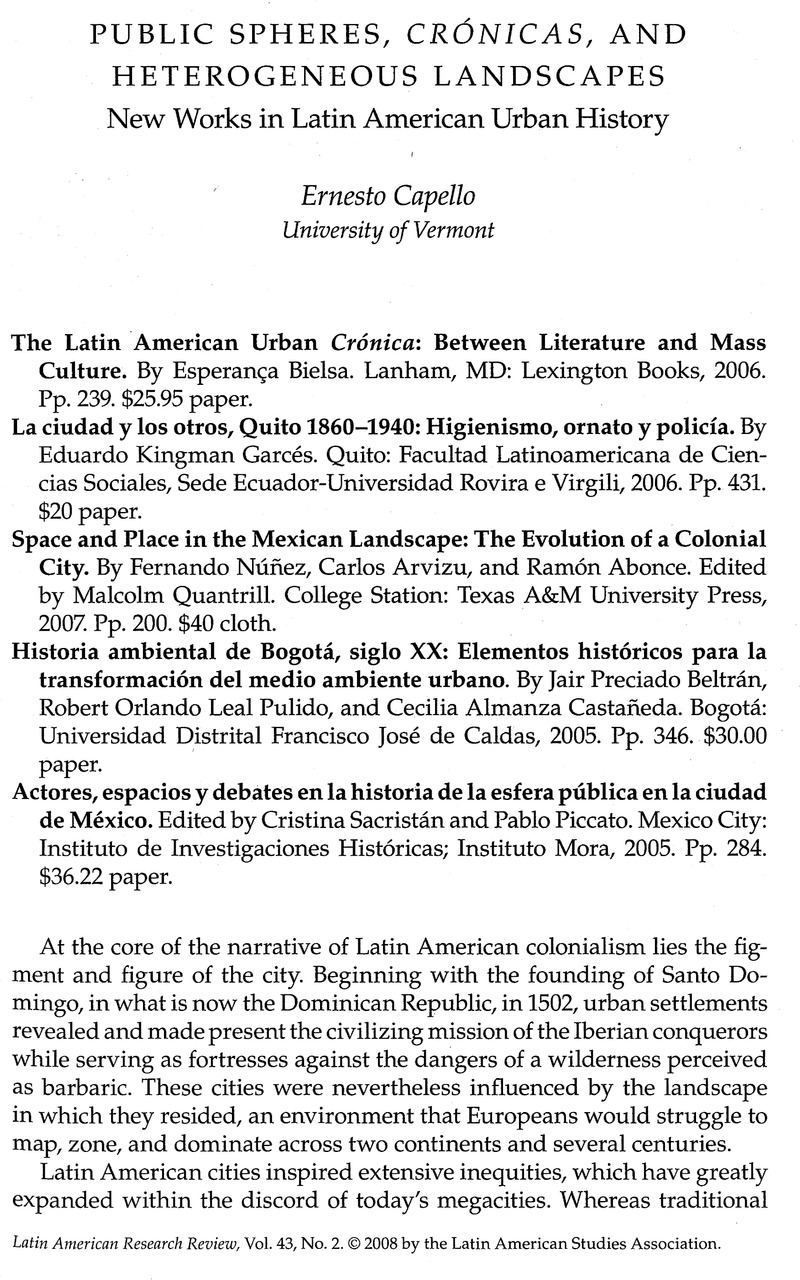No CrossRef data available.
Article contents
Public Spheres, Crónicas, and Heterogeneous Landscapes: New Works in Latin American Urban History
Review products
Published online by Cambridge University Press: 05 September 2022
Abstract

- Type
- Review Essays
- Information
- Copyright
- Copyright © 2008 by the University of Texas Press
References
1. Manuel Castells, City, Class and Power, trans. Elizabeth Lebas (New York: St. Martin's Press, 1978; Manuel Castells, The Urban Question: A Marxist Approach, trans. Alan Sheridan (Cambridge: MIT Press, 1977).
2. José Luis Romero, Latinoamérica: Las ciudades y las ideas (Mexico City: Siglo Veintiuno Editores, 1976); Richard M. Morse, New World Soundings: Culture and Ideology in the Americas (Baltimore: Johns Hopkins University Press, 1989); Richard M. Morse and Jorge Hardoy, eds., Rethinking the Latin American City (Washington, DC: Woodrow Wilson Center Press; Baltimore: Johns Hopkins University Press, 1992); Ángel Rama, La ciudad letrada (Montevideo: Comisión Uruguaya pro Fundación Internacional Ángel Rama, 1984).
3. On criminality, see Pablo Piccato, City of Suspects: Crime in Mexico City, 1900–1931 (Durham, NC: Duke University Press, 2001). For urban planning and sanitation, see Teresa Meade, Civilizing “Rio”: Reform and Resistance in a Brazilian City, 1889–1930 (University Park: Pennsylvania State University Press, 1997) and Adrián Gorelik, La grilla y el parque: Espacio público y cultura urbana en Buenos Aires, 1887–1936 (Buenos Aires: Universidad Nacional de Quilmes, 1998). Some of the most interesting work on collective identities has been in colonial historiography. See particularly Richard Kagan, Urban Images of the Hispanic World, 1493–1793 (New Haven, CT: Yale University Press, 2000) and Tamar Herzog, Defining Nations: Immigrants and Citizens in Early Modern Spain and Spanish America (New Haven, CT: Yale University Press, 2003).
4. Julio Ramos, Desencuentros de la modernidad en América Latina: Literatura y política en el siglo XIX (Mexico City: Fondo de Cultura Económica, 1989).
5. Bielsa acknowledges that some earlier crónicas meet her criteria; for an analysis of one such example, see Ernesto Capello, “City, Chronicle, Chronotope: Re-Constructing and Writing Old Quito,” Journal of Latin American Urban Studies 6 (Fall 2004): 37–56.
6. Eric Zolov, Refried Elvis: The Rise of the Mexican Counterculture (Berkeley: University of California Press, 1999); O. Hugo Benavides, The Politics of Sentiment: Imagining and Remembering Guayaquil (Austin: University of Texas Press, 2006).
7. On habitus, see Pierre Bourdieu, Distinction. A Social Critique of the Judgment of Taste, trans. Richard Nice (Cambridge, MA: Harvard University Press, 1984).




